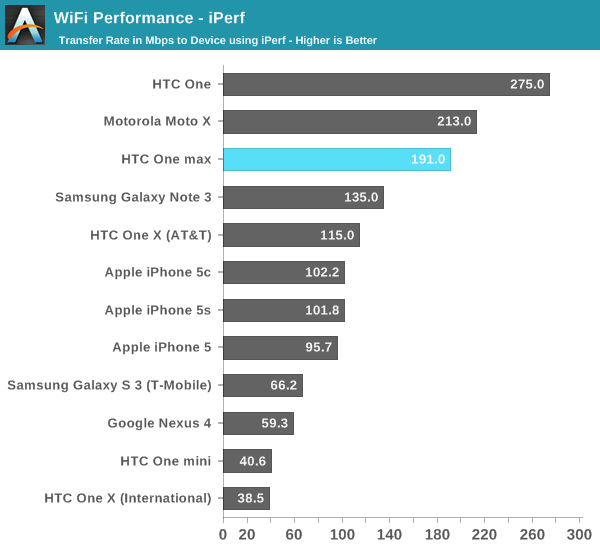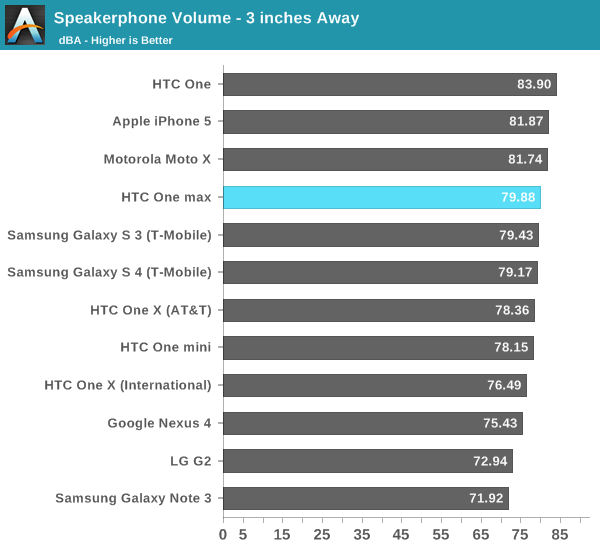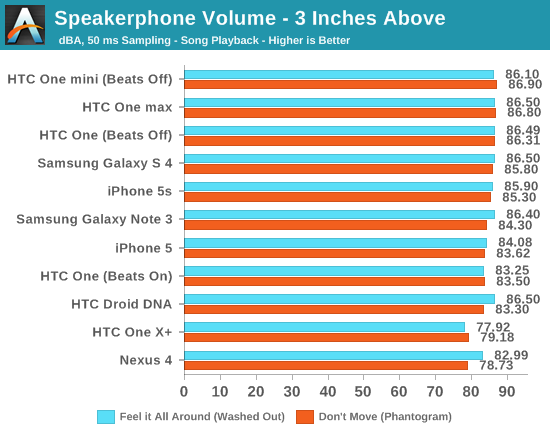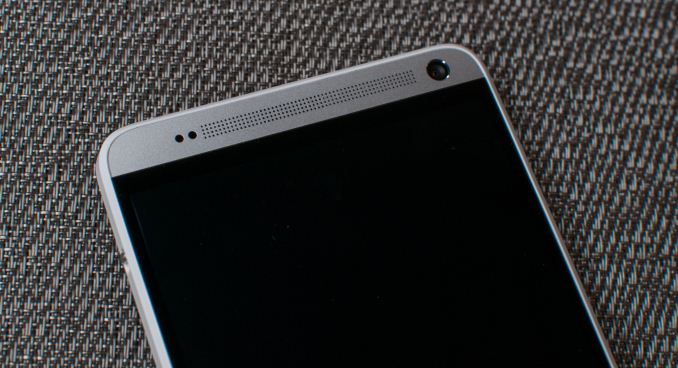HTC One max Review - It's Huge
by Brian Klug on October 28, 2013 10:00 AM EST- Posted in
- Smartphones
- HTC
- Mobile
- One
- Snapdragon 600
- Android 4.3
- One max
Cellular
Cellular on the One max is pretty much the same story as the One, and another shared bullet point. The top and bottom metal cutouts are still the radiative surfaces of the antenna, and there’s still transmit and receive diversity as well to mitigate any unwarranted antenna detuning from holding the device. The unit I was sampled has LTE banding for EMEA (Europe, Middle East, and Africa), but there’s appropriate banding for Asia, Sprint (a tri-mode device with 800/1900 MHz and TDD-LTE on 2600 MHz) and Verizon (700 MHz and AWS), according to the HTC specs page.
The baseband inside the One max is again shared with the One (Qualcomm’s 2nd generation multimode LTE MDM9x15 family), although the One max does have a bit more band support for the USA LTE on Sprint and Verizon, so the front ends are different.
WiFi
Interestingly enough with the One max we see HTC going to Qualcomm Atheros for the WLAN and BT combo, best I can tell this is the WCN3680 which is probably a bit cheaper to include than the BCM4335 we saw in the One. It’s still a single spatial stream 802.11ac capable part, meaning a PHY rate of up to 433 Mbps if you’re in the right channel conditions with 80 MHz channels on 5 GHz. The WCN3680 combo is the 802.11ac successor to WCN3660 which we saw in a number of phones last generation, and is accelerated by the SoC. WCN3680 also does BT 4.0, and FM Rx/Tx if applicable.

To test throughput on the One max I used iPerf the same way I have for a while now. Subjectively there are no complaints from me about WLAN connectivity on the One max, no random dropouts or issues, and Sense 5.5 thankfully still includes the WiFi frequency band manual selection option.
I saw the WCN3680 solution inside Moto X already, it’s interesting to see it in the One max. I believe the One mini uses its 802.11n cousin, WCN3660 as well, probably again for cost reasons.
Speakerphone
Although Beats is gone since that partnership has ended as of the One max, the device still seems to retain everything that made it sound great. There are still the larger-than-typical speaker chambers, big speaker grilles on the top and bottom, stereo sound, and importantly the TFA9887 speaker amplifier and protection part from NXP. In addition there’s still the TPA6185 headphone amplifier as well.
Beats always seemed to be an audio compressor that ran on the DSP, ostensibly through the Hexagon DSP access program or something, and that’s what’s absent on the One max. There’s no toggle under settings for enabling or disabling it, nor the Beats branding, but to be honest I almost always disabled Beats on the One anyways since it was a fair amount louder with it disabled. What made the One great was all the hardware behind the speakers, not so much the software compressor.


The One max goes plenty loud just like the original One. I went ahead and added the One mini and 5s to the chart too, just to check whether things have changed much, in addition to the Galaxy S 4 and Note 3. The One max basically performs like the One with Beats turned off, which isn’t a surprise since it isn’t there anymore. There’s also no detectable saturation, and the One line remains the only device that doesn’t sound tinny or rattly with overemphasized highs and lacking mids. I suspect the A weighting I selected a while ago for measuring might be a contributing factor as well. Either way you’re not going to be wanting for more loudness on the One max, and the inclusion of front firing stereo speakers makes for a completely different listening experience.












197 Comments
View All Comments
whatsa - Sunday, November 3, 2013 - link
Yes I have to admit brian has some odd perspectives at times.I find it easier when I remind myself that
" Es not the Messiah! - Es just a naughty naughty BOY!"
Impulses - Monday, November 11, 2013 - link
I could see something like Meenova's reader coming a mile away once USB OTG support became common place... I'm just surprised it took a Kickstarter campaign to make it a reality, and that it isn't more popular given this apparent need for removable storage amongst enthusiasts.I also thought we'd see USB OTG flash drives before we saw a USB OTG reader.... Though I guess it wouldn't be much smaller since you can't hide the flash memory inside the male connector itself like some of the full size USB microSD readers do.
UltraTech79 - Sunday, November 10, 2013 - link
Stupidly large.jshsimpson1 - Friday, November 15, 2013 - link
most note users do use their pens. I have the note 2 and the spend in one of the reasons I bought it among it being awesome. I love snote and I use it alot. I have a flip case which turns into a stand so that is useful for writing.fokka - Monday, December 9, 2013 - link
in the chart comparing the one/mini/max on the first page the mini is stated to have 4x krait 200 cores. as i understand, the mini is dualcore only and looking at the info on this page http://www.qualcomm.com/snapdragon/processors/400i believe it uses krait 300 cores because it's clocked at 1,4ghz.
hangfirew8 - Tuesday, December 17, 2013 - link
As always I really appreciate the depth and clarity of Brian's reviews. I've noticed one thing really missing from all, and perhaps that is because review hardware simply doesn't come with this accessory- car docks are not mentioned. After struggling with a poorly implemented car mode on the HTC Thunderbolt, I am very curious how well it works with the HTC dock. After all, one really good reason to buy a phablet over a normal size phone is that a phablet is the ideal form factor for a satnav app running docked. (Another good reason is to ditch a separate e-reader and just carry one device, not really a flaw in the review but this isn't really mentioned. I'm sure many buyers have this in mind when they buy that really, really big phone.acruhl - Saturday, April 12, 2014 - link
Sorry, I haven't read all posts. I liked the review for the most part. And I see someone was in Tucson to take the video, cool. I'm in Tucson.The HTC one max is my first smart phone (!) and I've been around since the early 70's. I got away with a pay as you go phone and an ipod up until now.
I wanted a bigger phone that could be used more like a laptop in a pinch for a new job I'm getting. I might need a keyboard for cli stuff, and using something like VNC is easier on a bigger, higher resolution screen is better.
For me, lots of this nitpicky stuff doesn't matter. I wanted a high quality, large screen and something I could hold onto reasonably well. The Mega doesn't have the screen quality. The Note is built around the stylus which I won't use. The SD card slot helps because I want to store all 30+ gigs of my music plus a few more gigs of videos (work related) on the phone. Not possible with the internal storage and software build.
Can someone explain to me why CPU speed is so important on a phone? For my laptop/home computer, the only thing I need CPU for is games or if I need a virtual machine to get a certain type of job done. Otherwise, I can wait, it's not a big deal. Even the virtual machine using my CPU isn't a huge problem, I'm patient :)
Tech for tech's sake is not productive. I haven't needed a faster CPU in my laptop or home computer for years. Memory, sure :)
The deal breaker for me on this HTC is the rattling vibration feedback. Holy cow, what were they thinking? But I don't like the other big phones so I have to decide if I can live with it.